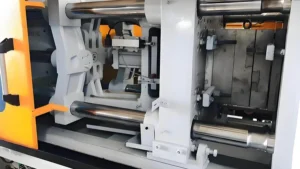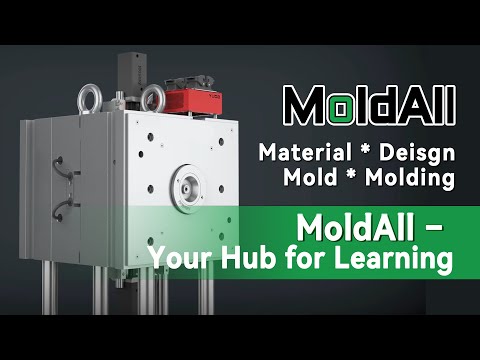Okay, so picture this. You're driving down the road and you pass one of those massive construction sites, you know, with stacks of giant orange storage bins.
Yeah, yeah.
Have you ever stopped to think how those things are even made?
Right.
Turns out it's all down to these incredible machines called injection molding machines. And that's exactly what we're diving into today.
Sounds good.
Our source material is all about these machines. I've been reading through it and yeah, it's. It's pretty dense.
It is. It's definitely geared toward, like a real technical audience. Engineers, maybe people who work in manufacturing.
Yeah, for sure.
So we're going to try to break it down.
Exactly. Make it understandable and hopefully fascinating for everyone else.
Absolutely.
So one thing that really jumped out at me was this idea of machine size and how that basically dictates what kinds of things you can make.
Right.
I mean, I get that a tiny machine probably can't crank out a kayak, but, like, the specifics of how that all works are a total mystery to me.
Well, one of the key things to understand is the mold opening stroke. Okay, so think of it like this. The machine has to open wide enough to fit the mold inside. Right?
Right.
And then it has to clamp shut with incredible force to inject the molten plastic.
Got it.
So bigger machine, bigger mold, bigger object it can produce.
Okay, that makes sense. So like, if a company wants to make both tiny things like phone cases and huge things like those construction bins we were talking about, they would need completely different machines.
Exactly. And our sources actually break this down really well. So you've got small machines, okay. They have a clamping force, so that's how much force they can use to hold that mold closed. Anywhere from 30 to 100 tons.
Okay.
And those small machines, they have strokes of a few hundred millimeters up to around 650 millimeters.
So those are the ones making our earbuds and LEGO bricks.
Then you got it.
So cool.
Then you step up to the medium sized machines. Those have 100 to 500 tons of clamping force and their strokes are more like 600 millimeters to 1500 millimeters. Those are handling car parts, maybe some larger toys, you know, things like that.
It's already kind of blowing my mind how much thought goes into this. I never would have thought about what kind of machine was needed just to make a thing.
It's amazing, isn't it? And then, and then you get to the real heavy hitters. Machines over 500 tons with strokes exceeding 2000 mm Whoa.
Okay.
Like, one of the sources mentions an 850 ton behemoth with a stroke of 2100 mm.
That's over 2 meters.
I know. Those are the ones making the truly massive stuff, like those storage bins you mention. Or even parts for airplanes.
Wow. Okay, I'm officially impressed.
Right.
So it's not just about making something big or small, but the machine itself has limitations based on its size and how wide it can open.
Exactly.
And I'm guessing that means choosing the wrong size machine could be a very costly mistake.
Oh, absolutely. Like, if you pick a machine that's too small, you're looking at production delays, possibly damaged equipment, and potentially even products that simply can't be made.
Oh, no.
But if you go too big, then you're wasting energy and resources, which also.
You know, hurts the bottom line.
Right. So finding that Goldilocks machine, not too big, not too small, that's key.
Yeah.
Is there anything else manufacturers have to consider besides just the physical size of the thing they're trying to make?
Yeah, for sure. There's another factor called mold thickness capacity.
Okay.
And this isn't just about the dimensions of the object, but also the material being used and the complexity of the design.
So even if you could fit a mold into a certain machine, there might be other reasons why it wouldn't work.
Exactly. Think about it this way. You wouldn't try to bake a giant thick cake in a tiny pie pan. Right?
Okay. Yeah.
It's kind of the same principle here.
Makes sense.
So small machines, they can usually handle mold thicknesses up to around 400 millimeters.
So, like, good for things like phone cases, but not for, like, a sturdy toolbox.
Exactly. Larger machines can handle much thicker molds, sometimes over 1,000 millimeter.
Wow.
But here's the catch. The material you're molding with plays a huge role too.
Oh, right, right.
Some plastics are more viscous, meaning they're.
Thicker and more resistant to flow.
Okay. So it's almost like choosing the right consistency of batter for pancakes.
Yeah.
Like too thick and it won't cook properly.
Right.
Too thin and you just end up with a floppy mess.
That's a great analogy.
Thanks.
And just like with your pancake batter, choosing the wrong material viscosity for a given mold thickness, well, that can lead to all sorts of problems during the injection process.
Okay, so just to recap, we've got machine size influencing what size object can be made, and then this idea of mold thickness capacity, which is affected by both the machine and the material properties. And I'M guessing design complexity throws another wrench in the works.
You're absolutely right. So if you've got a really intricate design with lots of fine details.
Right.
You might need a thinner mold to capture all those nuances. Yeah, it's kind of like trying to carve a super detailed sculpture out of a block of wood.
Gotcha.
You need thin, precise tools to get those fine lines and textures right. On the other hand, if you have a simpler design, well, you can use a thicker mold.
Yeah.
And that adds durability to the final product.
So it's like this constant balancing act between the capabilities of the machine, the properties of the material, and the complexity of the design.
Exactly. It's this intricate interplay that determines the success of any injection molding project. But. But choosing the right machine and understanding these factors, well, that's just the first step. We also need to make sure that the mold is installed correctly within the machine.
Wait, so there's even more to it?
Oh, yeah.
I thought once you picked the right machine and mold, you were basically good to go.
Oh, no, there's a lot more to it than that. Proper installation is absolutely critical.
Okay.
And even seemingly small mistakes can have huge consequences for both the quality of the product and the efficiency of the whole production process.
Okay, I am sensing a story here. What kind of disasters can happen if you don't get the installation right?
Well, let's just say it can get pretty messy and sometimes even dangerous. But before we dive into all that, maybe we should take a quick break.
Yeah, that sounds good. We'll be back in a few minutes to explore the wild world of mold installation. Okay, so we've established that picking the right injection molding machine is crucial. And it's not as simple as just grabbing the biggest one on the lot. But then you mentioned this whole other layer of complexity. Proper mold installation.
Right.
I'm really curious to hear what kind of chaos can unfold if that goes wrong.
Well, imagine this. You've invested in this top of the line machine. You've got your perfectly designed mold, the right material, everything set for a smooth production run. Yeah, but then the mold isn't installed correctly, and the whole thing goes haywire.
Okay. That's like a nightmare scenario for any manufacturer.
Oh, yeah.
What are we talking about here? Melted plastic spewing everywhere? Explosion.
Not quite that dramatic.
Okay.
But the consequences can be just as devastating. One common issue is uneven filling of the mold cavity.
Okay.
So if the mold isn't aligned properly, the plastic might not flow into all the nooks. And crannies, leaving you with incomplete parts or what's called short shots.
So it's like trying to pour batter into a cake pan that's, like, tilted at a weird angle. You're going to end up with a lopsided mess.
Exactly. And then there's the opposite problem called flash.
Flash.
Yeah. This is where excess plastic squeezes out between the mold halves.
Okay.
Creating these unsightly burrs, or protrusions on the finished product.
So not only are you wasting precious material with both of those scenarios, but you're also ending up with defective products that probably can't be sold.
Exactly. And it's not just about the immediate impact on the products themselves.
Oh, no. What else?
Improper installation can also wreak havoc on the machine itself.
Oh, no. So I'm guessing forcing a misaligned mold into the machine is a recipe for disaster.
You got it. It puts immense stress on the clamping unit, the part of the machine that holds the mold closed during injection. Over time, this can lead to, you know, premature wear and tear breakdowns and costly repairs.
So it's like trying to jam a square peg into a round hole. Eggs. Eventually, something's going to break.
Right. And those repairs can be expensive, Both in terms of the actual cost of parts and the downtime while the machine is out of commission.
Okay, I think I'm getting the picture. Improper installation equals wasted material, defective products, and damage to the machine. So how do we avoid this catastrophe? What's the secret to getting it right?
Well, first and foremost, you need to make absolutely sure that the mold you've chosen is compatible with the machine.
Okay.
They need to be a perfect match, like two pieces of a puzzle.
So we're back to that idea of matching capabilities, right? Mold size, clamping force, all of that.
Exactly. But you also need to check things. The mold's dimensions, the type of ejection system it uses, and even the location of cooling channels. All of these factors need to align with the machine's specifications.
Yeah, it sounds like there's a lot of room for error if you're not paying close attention. Are there any tools or techniques that help ensure everything is lined up perfectly?
Absolutely. Many manufacturers use specialized alignment devices and sensors to help guide the installation process. These tools can detect even the slightest misalignment.
Wow.
Allowing technicians to make. Make adjustments before anything gets damaged.
So it's like having a super precise level to make sure everything is perfectly straight.
Yeah, that's a good analogy. And, of course, having a skilled and experienced technician overseeing the installation is Crucial, of course. They'll know how to interpret the readings from those tools and make the necessary adjustments to achieve that perfect fit.
Okay, so compatible mold and machine, specialized tools, expert technicians. It's starting to sound less like a chaotic mess and more like a carefully orchestrated process.
It definitely is. But even with all the right equipment and expertise, there's one more absolutely critical element. Meticulous attention to detail.
So no cutting corners or rushing through the steps.
Exactly. The manufacturer's instructions are like the holy grail of mold installation.
Got it.
They need to be followed precisely, step by step.
So it's not just about knowing how to use the tools, but also having that deep understanding of the specific mold and machine you're working with.
Absolutely. Each machine and mold will have its own unique quirks and requirements. And those details can make all the difference between a successful installation and a costly mistake.
Yeah. This is really making me appreciate the level of expertise that goes into making even the simplest plastic products. It's not just about melting some plastic and pouring it into a mold.
Right.
It's a complex and fascinating process. With so many factors to consider.
You've hit the nail on the head. Injection molding is truly a blend of science, engineering, and artistry. But before we get too philosophical, there's one more crucial decision that manufacturers have to make when setting up their injection molding operation. Choosing the right type of machine.
Oh, right. We touched on this earlier. Hydraulic, electric, and hybrid. I'm guessing each one has its own set of pros and cons. It's probably not a one size fits all situation.
You're absolutely right. Choosing the right type of machine depends on a whole host of factors, from the specific products being made to production volume, and even energy efficiency goals.
All right, well, lead the way. I'm ready to unravel the mysteries of hydraulics, electricity, and the intriguing world of hybrid machines. Okay, so we've talked about picking the right size injection molding machine and understanding that mold thickness thing and how important it is to install the mold correctly.
Right.
And all the crazy things that can go wrong if you don't. But now we're on to choosing between hydraulic, electric, and hybrid machines.
Right. So it's kind of like choosing a car, you know?
Okay.
You wouldn't pick a sports car to haul a trailer. Right. Each type of injection molding machine has its own, like, strengths and weaknesses. Yeah. So it's really important to consider those when deciding which is best for a specific manufacturing operation.
Okay, so let's start with the classic the hydraulic machines. What are Their, like, defining characteristics.
So hydraulic machines have been around forever. They've been the workhorses of the industry for decades.
Got it.
They use hydraulic fluid to generate the force needed to clamp the mold shut and inject the molten plastic.
Okay.
They're known for their raw power and their ability to just handle those really demanding, high volume production runs.
So they're like the heavy duty pickup trucks of the injection molding world.
Exactly.
Reliable, powerful, but maybe not the most fuel efficient.
Exactly. Hydraulic machines can be a bit energy hungry compared to electric machines, and they tend to require more maintenance because of the complex hydraulic systems.
Yeah, that makes sense.
But they're also incredibly durable, and they can withstand a lot of wear and tear.
Makes sense. So where do electric machines fit into all of this?
Yeah, so electric machines are kind of like the opposite. They seem to be gaining popularity lately, and for good reason. They're like the sleek sports cars of the injection molding world.
Okay.
They use electric servo motors to power the clamping and injection units, which gives them some big advantages in terms of precision, speed and energy efficiency.
So they're more agile and nimble. Yeah, but can they handle the same heavy lifting as a hydraulic machine?
They might not have the same brute force, but they really excel in applications where precision and repeatability are super important. Like, think about making small, intricate parts with tight tolerances. That's where electric machines really shine.
Interesting. So it's like a trade off. Raw power versus precision and efficiency.
Exactly.
And then we have the hybrids.
Yeah.
Which I'm guessing could combine elements of both.
Precisely. Hybrid machines are kind of like the versatile SUVs of the injection molding world.
Okay.
They use both hydraulic and electric systems, so they offer this nice balance of power and efficiency.
Got it.
They can provide that high clamping force needed for larger molds, but they also offer the speed and precision of those electric servo motors for specific tasks within the injection cycle.
It sounds like hybrids offer the best of both worlds. They often do, but I'm guessing they're probably the most expensive option they can be.
Yeah. Yeah, but the key is to look at the long term cost of ownership.
Right.
Hybrid machines often save you money on energy, and they have reduced maintenance costs over time, which can offset that higher initial investment.
So it's not just about the sticker price, but also considering the ongoing operating costs and potential savings down the road.
Exactly. And of course, you know, the specific application is going to be really important in deciding which type of machine is the best fit.
Of course.
So a manufacturer producing high volumes of, you know, simple parts might be perfectly happy with a reliable hydraulic machine.
Yeah.
But a company making, let's say, intricate medical devices might need the precision and repeatability of an electric machine.
Yeah. And for those who need a bit of both, there's always the trusty hybrid option.
Right. There you go.
Well, this has been incredibly enlightening.
I'm glad to hear that.
I feel like I've gone from knowing absolutely nothing about injection molding to actually understanding the basics.
That's great.
And the next time I pick up a plastic product, I'll definitely be thinking about all the steps and decisions that went into creating it, from the type of machine to the mold design, and even the specific material.
That's awesome.
It's amazing.
Yeah, it's a really fascinating process when you get into it.
Well, I can't promise I'll be designing my own molds anytime soon, but I'm definitely looking at plastic products differently now.
That's great to hear.
Thanks for joining us on this deep dive into the world of injection molding.
My pleasure. Thanks for having




